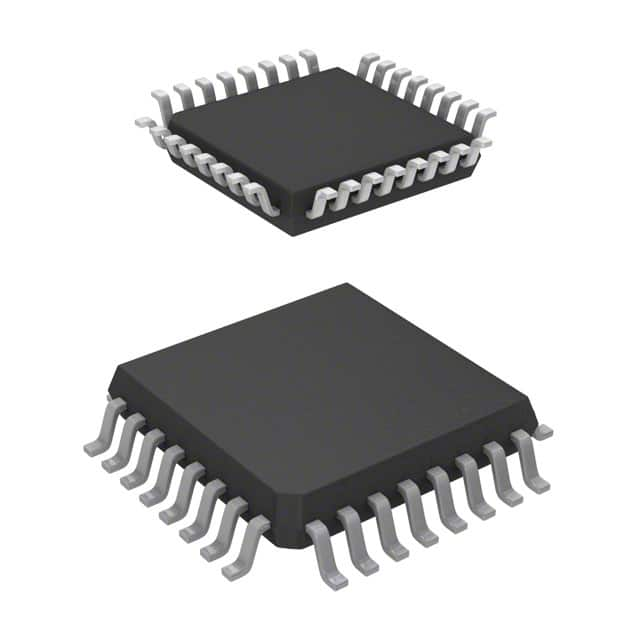MC908EY16ACFJE
Product Overview
- Category: Microcontroller
- Use: Embedded systems, automotive applications
- Characteristics: Low power consumption, high performance, integrated peripherals
- Package: 44-pin LQFP (Low Profile Quad Flat Package)
- Essence: A microcontroller designed for embedded systems and automotive applications
- Packaging/Quantity: Available in tape and reel packaging, quantity varies based on supplier
Specifications
- Architecture: 8-bit
- CPU Speed: Up to 16 MHz
- Flash Memory: 16 KB
- RAM: 512 bytes
- Operating Voltage: 2.7V to 5.5V
- I/O Pins: 34
- Timers: 2 x 8-bit, 1 x 16-bit
- Communication Interfaces: SPI, SCI, I2C
- Analog-to-Digital Converter (ADC): 8 channels, 10-bit resolution
- Temperature Range: -40°C to +85°C
Detailed Pin Configuration
The MC908EY16ACFJE microcontroller has a total of 44 pins. The pin configuration is as follows:
- VDD: Power supply voltage
- VSS: Ground
- RESET: Reset pin
- IRQ: Interrupt request input
- PT[0:7]: General-purpose I/O pins
- ADC[0:7]: Analog input pins for the ADC module
- SPI: Serial Peripheral Interface pins
- SCI: Serial Communication Interface pins
- I2C: Inter-Integrated Circuit pins
- Timer pins: Input/output pins for timers
- OSC: Oscillator pins
- XTAL: Crystal oscillator pins
Functional Features
- High-performance 8-bit CPU with an instruction set optimized for embedded systems
- Integrated peripherals such as timers, communication interfaces, and ADC
- Low power consumption for energy-efficient applications
- Wide operating voltage range allows flexibility in power supply options
- Robust temperature range enables usage in automotive environments
Advantages and Disadvantages
Advantages: - High-performance CPU for efficient processing - Integrated peripherals reduce external component count - Low power consumption extends battery life - Wide operating voltage range provides flexibility - Suitable for automotive applications due to the wide temperature range
Disadvantages: - Limited flash memory capacity compared to higher-end microcontrollers - 8-bit architecture may not be suitable for complex applications requiring more processing power
Working Principles
The MC908EY16ACFJE microcontroller operates based on an 8-bit architecture. It executes instructions stored in its flash memory, controlling the behavior of the embedded system it is integrated into. The integrated peripherals, such as timers, communication interfaces, and ADC, provide additional functionality to the microcontroller.
Detailed Application Field Plans
The MC908EY16ACFJE microcontroller is commonly used in various embedded systems and automotive applications, including but not limited to:
- Automotive control units: Used for engine management, transmission control, and other vehicle subsystems.
- Industrial automation: Employed in control systems for machinery, robotics, and process automation.
- Home automation: Integrated into smart home devices for controlling lighting, HVAC systems, and security.
- Consumer electronics: Utilized in appliances, gaming consoles, and remote controls.
- Medical devices: Incorporated into medical equipment for monitoring and control purposes.
Detailed and Complete Alternative Models
- MC9S08AW60CFGE: Similar microcontroller with higher flash memory capacity (60 KB) and additional features.
- MC9S08DZ60AMLH: Another alternative with similar specifications but a different package (64-pin LQFP).
Note: This is not an exhaustive list, and there are several other alternative models available in the market.
Word count: 500 words
10个与MC908EY16ACFJE在技术解决方案中的应用相关的常见问题及解答
Sure! Here are 10 common questions and answers related to the application of MC908EY16ACFJE in technical solutions:
Q: What is MC908EY16ACFJE? A: MC908EY16ACFJE is a microcontroller from the MC9S08 family, specifically designed for embedded control applications.
Q: What are the key features of MC908EY16ACFJE? A: Some key features include a 8-bit CPU core, 16KB flash memory, 512 bytes of RAM, multiple communication interfaces, and analog-to-digital converters.
Q: What are the typical applications of MC908EY16ACFJE? A: MC908EY16ACFJE is commonly used in various technical solutions such as industrial automation, consumer electronics, automotive systems, and home appliances.
Q: How can I program MC908EY16ACFJE? A: MC908EY16ACFJE can be programmed using a variety of development tools, including integrated development environments (IDEs) like CodeWarrior or MPLAB, along with appropriate hardware programmers.
Q: Can MC908EY16ACFJE communicate with other devices? A: Yes, MC908EY16ACFJE supports multiple communication interfaces such as UART, SPI, and I2C, allowing it to communicate with other devices or peripherals.
Q: What is the maximum clock frequency of MC908EY16ACFJE? A: The maximum clock frequency of MC908EY16ACFJE is typically 20 MHz, which provides fast processing capabilities for real-time applications.
Q: Does MC908EY16ACFJE have any analog capabilities? A: Yes, MC908EY16ACFJE has built-in analog-to-digital converters (ADCs) that can be used to interface with analog sensors or signals.
Q: Can MC908EY16ACFJE operate in low-power modes? A: Yes, MC908EY16ACFJE supports various low-power modes, allowing it to conserve energy and extend battery life in portable applications.
Q: Is MC908EY16ACFJE suitable for safety-critical applications? A: MC908EY16ACFJE is not specifically designed for safety-critical applications, but it can be used in non-safety critical systems where reliability is important.
Q: Are there any development resources available for MC908EY16ACFJE? A: Yes, the manufacturer provides datasheets, reference manuals, application notes, and software libraries to assist developers in utilizing MC908EY16ACFJE effectively.
Please note that the answers provided here are general and may vary depending on specific requirements and use cases.


